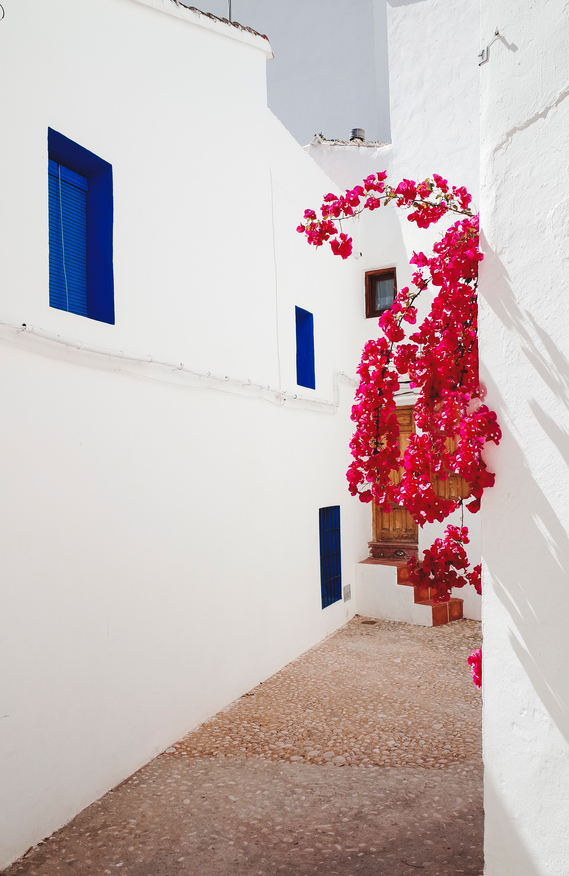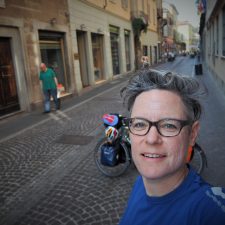
There are orange blossoms everywhere, fields and fields of them. The scent is heady and exquisite. It’s early still so the fields are deserted, and I am sitting in the middle of one of them, soaking it all in, my spirits high. It is going to be a fine day and I am on an adventure to discover the real Andalucía, not the fish and chip pseudo English version of Malaga but the authentic Andalucía of whitewashed villages, exquisite food and a pinch of gypsy magic.
The first thing I notice are the brilliant colours: big blue skies, a flash of red on a whirling flamenco dancer and the lush purple and pink bougainvillea trailing over walls of an Arabic-style courtyard.
My GPS is set to follow the route of “Los Pueblos Blancos”, a charm bracelet of white towns perched on the hills of the Cadiz and Malaga regions of Andalucía. The stunning scenery – mountains, caves, lakes and gorges – makes a journey through the region an absolute joy. The towns themselves ooze history, most were built by Berbers tribes searching for high-protected places to keep safe in the centuries-long Moor-Christian conflict that culminated in the fall of Granada in 1492. Today, an air of tranquillity invites travellers to slow down and soak up the unique soul of the region.
Here is a look at five of the most spectacular white towns in Andalucía.
Acros de la Frontera
Be warned the drive up to this ancient town perched on a rocky outcrop will set your pulse racing. The payoff? Breathtaking views along with a visual feast of baroque facades and historical curiosities like the magic circle out in front of the church with its twelve red and twelve white stones. Historically, before entering the church on the day of a child’s baptism their parents would stop in the circle for an exorcism of any evil spirits. Today the church bells peals out the hours, adding to the romance.
Walking in Acros is the most practical way to get around. It affords a wonderful glimpse into the many private Moorish-style patios lining the way. Originally each courtyard served as a catchment system to funnel rainwater to a drain in the middle, which then filled the well. The tiny wells can still be seen in wall niches, nowadays they’re adorned with decorative pulleys and buckets.
Vejer de la Frontera
Vejer is one of those places that lives on in travellers’ memories, long after they return home, thanks to its majestic position atop a craggy buff with views to the nearby coastline and its fusion of Roman, Iberian and Moorish architecture. It was actually under Moorish rule for 500 years and the Arabic influence can still be seen in the thin alleyways and high walls and towers. Like many old fortress cities there is an inner wall that runs through the town. It is heavily scaring form the many battles fought there in the past.
It’s fascinating to see the juxtaposition of Christian and Arab styles side by side. For instance, in the centre of town, a walled enclosure with four Arabic horseshoe gates contains the 16th Century Mudejar and Gothic parish church of San Salvador (built over a mosque). Nearby is a Moorish castle as well as a Reconquest palace of the Marques de Tamaron along with a well-conserved Jewish Quarter.
Equally evocative are the many statues and other artworks across the town depicting women wearing traditional black dress and head covering. Even though the Christians reclaimed Vejer in 1250, the tradition continued until last century lending a distinctively Moroccan vibe to the village.
Rhonda
Rhonda is the largest and most famous of the pueblos blancos making it a bit of a shock after spending time wandering the countryside. But there’s a very good reason for the crowds. Few places can beat the dramatic location, straddling a deep gorge with thrilling views of the dramatic landscape. Besides its spectacular setting, Rhonda is famous for bullfighting and its Palaza de Toros is Spain’s oldest bullring. Bullfighting attracted the likes of Ernest Hemingway and Orson Welles (who is also buried there).
Strong Moorish associations are evident in the old town – from the Arab baths to the ornate cathedral, which was converted from a mosque when the Moors were permanently expelled from the area.
Jimena de la Frontera
In stark contrast you won’t find much evidence of tourism in Jimena, it’s a pueblo blanco in its purest form. Yes there are beautiful streets, and the ruins of the Moorish Castle, but Jimena’s real beauty lies in its surroundings: Los Alcornocales National Park. Here cork oak trees are shaved of their bark to create none other than the spongy cork we use to use in our wine bottles. This is definitely the place to bring your hiking shoes!
Zahara de la Sierra
Nestled at the foot of the Sierra del Jaralin at the northern end of the Grazalema Natural Park, Zahara de la Sierra is undoubtedly one of the most picturesque pueblo blanco.
High above the village, perched on its rocky outcrop, the remains of the Moorish castle stands guard over the whole valley. Scattered below on the slopes are the whitewashed houses of the village built around a central plaza, leaving the viewer with the impression of a magical, slightly unreal Moorish Brigadoon upon first sighting. Sights worth seeing in Zahara include the Watch Tower, the Tore del Homenaje, the Church of Santa María de la Meza with its baroque altarpiece and the Arch of the Town.


